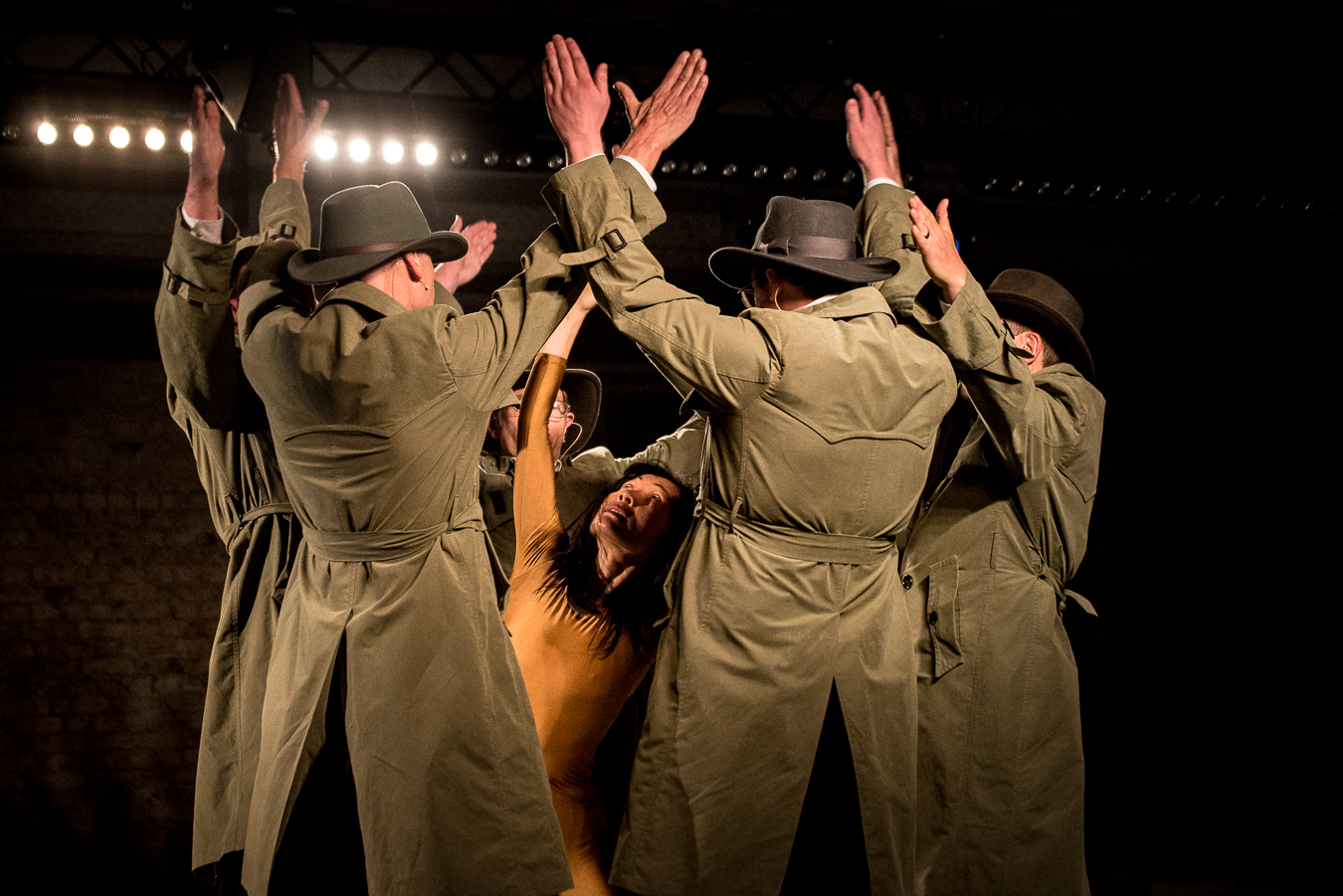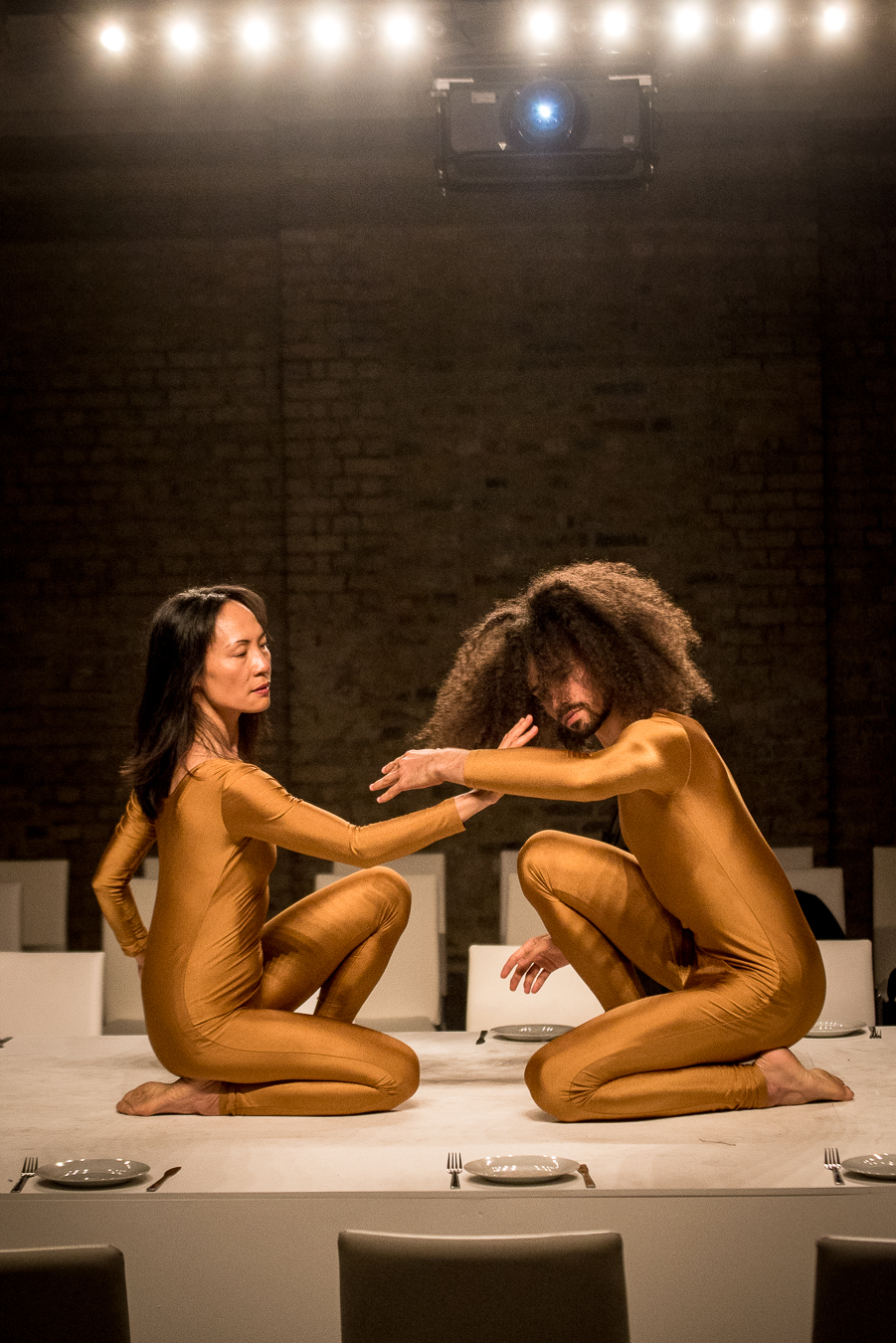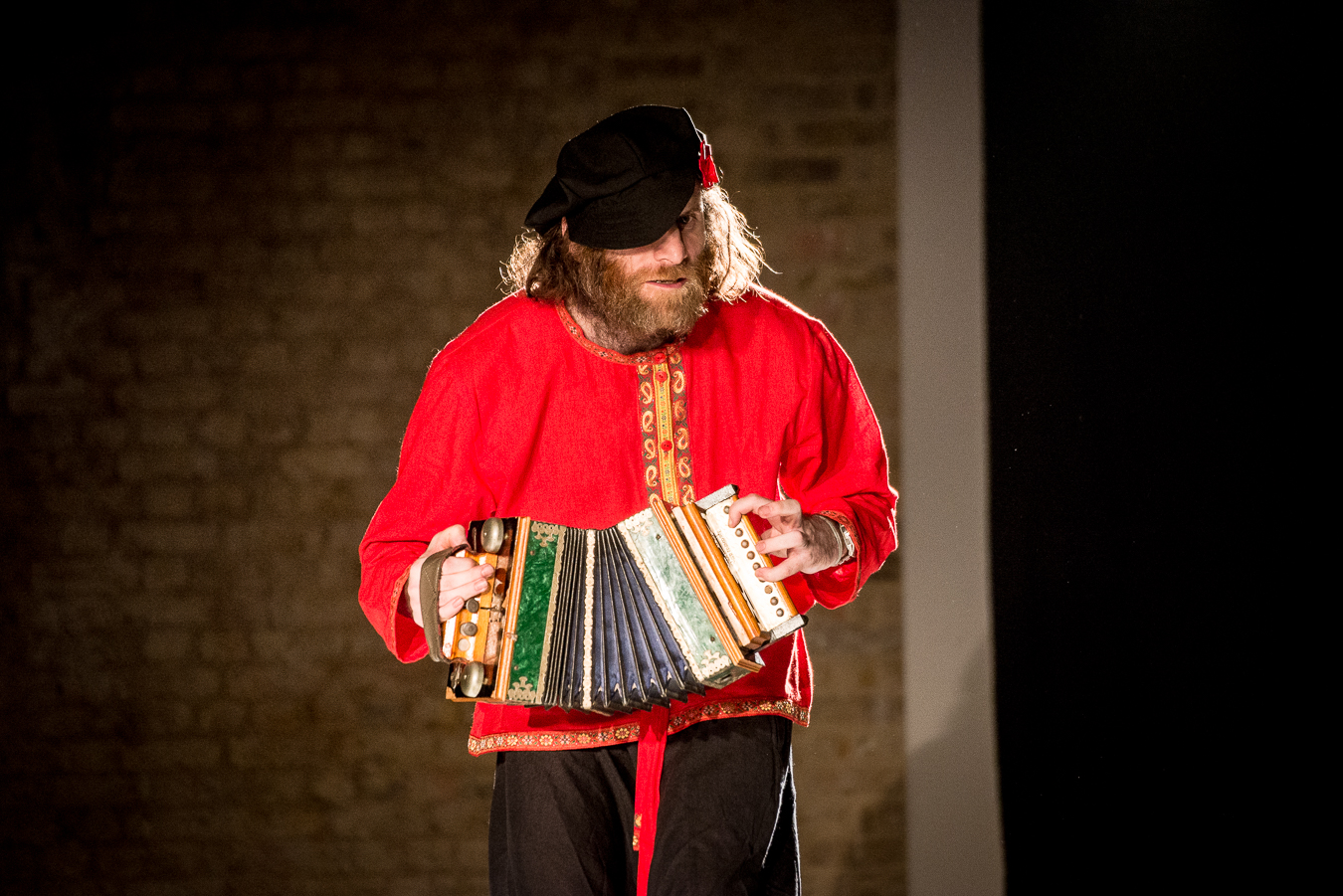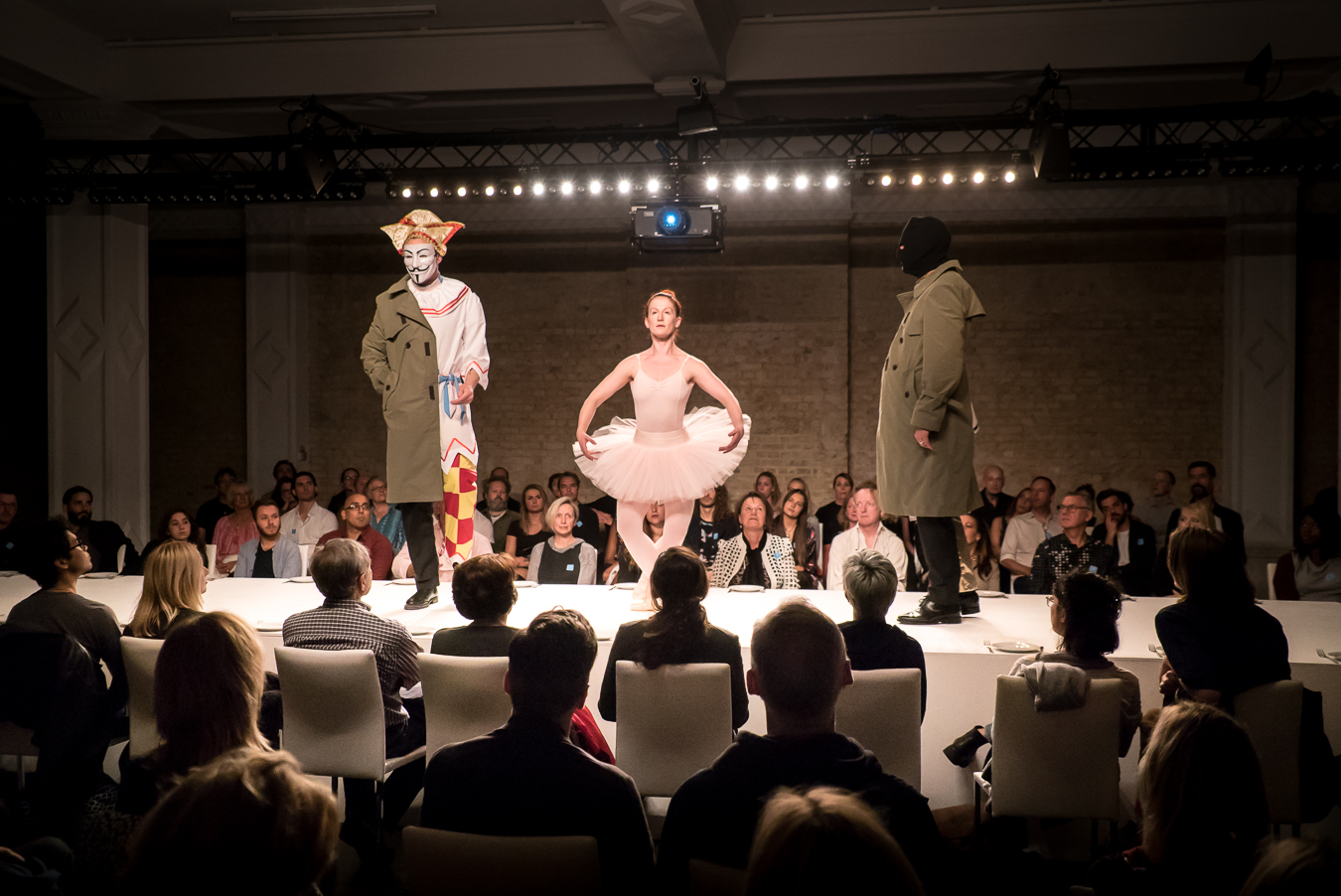 Using the framework of Stephen Fry’s book Incomplete & Utter History of Classical Music, Zakharov’s piece chronicled a momentous slice of history across politics, music and art from 1904 to 1917. The audience sat around a long stage set as a dinner table, across which performers pirouetted, bolted naked and marched in this comical and poignant journey back through time.
Using the framework of Stephen Fry’s book Incomplete & Utter History of Classical Music, Zakharov’s piece chronicled a momentous slice of history across politics, music and art from 1904 to 1917. The audience sat around a long stage set as a dinner table, across which performers pirouetted, bolted naked and marched in this comical and poignant journey back through time.
“The Tunguska event is a good metaphor for me,” Zakharov said. “You get the same explosions in the brain when you try to combine different aspects of our crazy life. I’m activating memory. After that, people should have an insight somehow and look at our world a bit differently.”
Zakharov is best known in the West for his theatrical piece Danaë at the 2013 Venice Biennale, in which gold coins rained from the Russian pavilion’s roof, to be gathered by women and mechanically transported back up for the cycle to repeat itself. The performance gave a contemporary twist to the Greek myth of Danaë, who was impregnated by Zeus disguised as a golden shower; Zakharov’s version became a meditation on capitalism and ethics amid the bling of Venice.

The Tunguska Event happened on 21 and 22 September and was commissioned by Russia’s V-A-C Foundation, which produces and presents Russian contemporary art in an international context. “This is a piece we have believed in from the very beginning, even when we didn’t know very much about it,” said V-A-C director Teresa Iarocci Mavica. “There is nothing superficial in his work. Everything is so linked with history. This is what I like, reading the past to understand what is going on now.”
The event coincides with the centenary of the Russian Revolution, although that comprised just one of many significant moments that were highlighted by performers in trench coats and fedoras. As the action began in 1904, it was announced that Russia and Japan were at war, Rolls Royce produced its first car, the first radio transmission of music occurred in Austria and Anton Chekhov died after writing The Cherry Orchard. Cue: a ballerina crossing the stage en pointe, leading a man in a dog mask in reference to Chekhov’s short story The Lady and the Dog.
The following year heralded the 1905 Russian Revolution, Debussy’s La Mer premiered in Paris, Las Vegas was founded and mutiny broke out on the Battleship Potemkin.
Names, years and milestones flashed by in a parade of recollections accompanied by music and slide projections—Oscar Wilde, Ibsen, Wagner, Stravinsky, Delius, Proust, Vaughan Williams, the sinking of the Titanic, the outbreak of World War One, Picasso’s Violin. For the year 1908, a naked man with an axe blasted across the table, symbolizing the Tunguska meteor.

Two of the most striking moments were a beautifully danced sequence evoking Maurice Ravel’s ballet Daphnis et Chloé, performed in 1912 by Sergei Diaghilev’s Ballets Russes, and the birth of the art movement Dada. For the latter, two men in frock coats drew the words DADA on their faces while reciting nonsensical words and then marched spectators across the stage, where an actor was ceremonially crowned with a replica of Marcel Duchamp’s Bottle Rack—adorned with toilet rolls in a nod to the famous urinal Fountain.
The Tunguska Event was the second live collaboration with the Whitechapel Gallery and is part of a five-year partnership with the V-A-C. The relationship grew out of a series of innovative exhibitions from 2014 to 2015 at the gallery, for which the artists Mike Nelson, Fiona Banner, Lynette Yiadom-Boakye and James Richards were given unfettered access to the V-A-C’s outstanding collection. (Nelson, for instance, chose to display ancient Nigerian Nok heads alongside masterpieces by Picasso, Brancusi and De Kooning on the floor, unprotected by glass or plinths.) “Museums can’t traditionally take those risks, so to give us that kind of freedom was absolutely extraordinary,” explained Whitechapel director Iwona Blazwick. “And because we’d had debates and talks and workshops around [the shows], our relationship got stronger and stronger.”
For the first V-A-C Live event last year, the Whitechapel hosted three nights of Russian cabaret acts, kicked off each evening by the artist William Kentridge, who had been profoundly influenced by the early Russian avant-garde. This year, however, the V-A-C decided to showcase one established artist. Moreover, with multiple artists involved the previous year, there were major headaches arranging visas. “The visas were a nightmare,” said Blazwick, “and I fear for our future with this Brexit business because we depend on that flow of international exchange and it’s going to become so difficult.”

Zakharov enjoys cult status among many Russians. He was part of the Moscow School of Conceptual Art and a member of a small anarchic movement called Apt-Art, which staged “anti-shows” in a private apartment and in outdoor spaces around Moscow in the early 1980s. The activities of these underground practitioners were followed by the KGB and Zakharov had various nude self-portraits confiscated for supposed pornography and homosexuality. “We were in a cage but at the same time we were totally free. Now it’s a zoo again,” he said. Zakharov lives in Berlin with his family but he still cherishes the spontaneity of Apt-Art, as evidenced by this deliberately unpolished progression through history, viewed through Stephen Fry’s quintessentially English lens.
“There is a temptation to make it smoother because you want it to be like a movie but this is very dangerous. It’s not the point, of course. Life isn’t smooth, history is not smooth at all,” said V-A-C’s Mavica. “This moment when you have mistakes because the work is unmade, this is the moment when the idea of contemporary art comes out.”
The Tunguska event was the largest impact event on Earth in recorded history, with a force about 1,000 times greater than that of the atomic bomb dropped on Hiroshima, but there were no known casualties because of its remote location. Zakharov points to the linguistic slippage between the Russian and British understanding of it. “In Russian it’s called a meteorite but in the English Wikipedia it’s the Tunguska event and for me this was strange. And so when I was asked to make an ‘event’ at the Whitechapel, I thought, perfect. This explains a difference between the two cultures.”

You can read more about the V-A-C in Elizabeth Fullerton’s piece in Issue 32. All photography by Daniel Zakharov.





